SPMTs serve as incredible transport tool
21 February 2022
Eddy Kitchen discusses how SPMTs safely and efficiently maneuver some of the most complex over-dimensional and over-weight loads that anyone could ever imagine.
In my initial approach to writing about the importance of the Self-Propelled Modular Transporter (SPMT) in rigging applications, I was overwhelmed at the vast amount of information to be considered that would adequately provide the full scope of the critical role of the SPMT. The technological advances of these machines are nothing less than incredible and would normally demand a critical analysis and description.
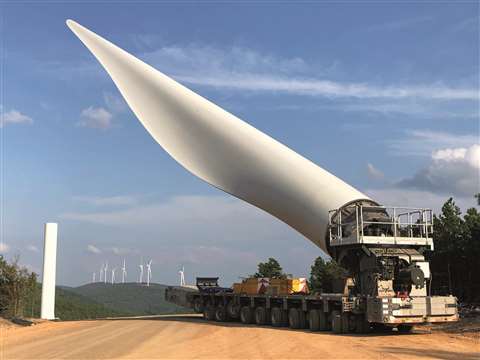 The size and length of wind turbine blades continue to challenge the access to new wind-project locations. Photo: OXBO Mega Transport and Mountain Crane
The size and length of wind turbine blades continue to challenge the access to new wind-project locations. Photo: OXBO Mega Transport and Mountain Crane
Very quickly, I realized that this entire article could easily be consumed by the unintentional engineering explanation of the SPMT, just as was required by the innovators back in the late seventies and early Eighties. Instead, my goal and focus changed to simply celebrate this highly specialized equipment by referencing some of its non-traditional uses as it continues to support the heavy-lift industry.
Incredible tool
Rather than discuss hydraulic suspensions, stability triangles, hydraulic loops, digital control systems, operating pressures, bending moments, spatial configurations, steering modes and the many other technical terms or aspects that exist in manufactured specifications of SPMTs, I will state what I believe to be the obvious. Undeniably, the SPMT is an incredible tool used worldwide to maneuver safely and efficiently some of the most complex over-dimensional and over-weight loads that anyone could ever imagine. Our industry continues, in a natural progression, to always push maximum capacity and enhance functional capability that appropriately leads us to the topic of alternative rigging uses for the SPMT.
Quality and efficiency from in-plant manufacturing continually promotes bigger and heavier components as is evident today in the wind energy industry. This seems to be the driving force behind the transport manufacturer’s innovative development of wind attachments, with one particularly used to maneuver and manipulate loads during transport. While the SPMT is not solely used as a rigging device, in this application, the engineering mind in all of us can realize the complexity of maintaining trailer and cargo stability during an inclined movement, while allowing various load manipulations.
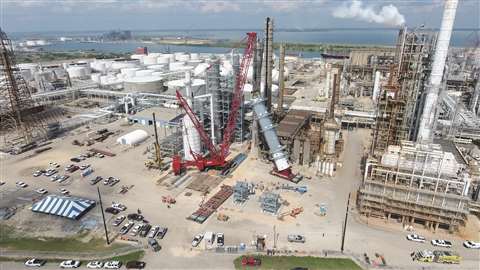 The main crane, the sizable vessel and the double-wide configuration of the hi-spec SPMT as a tailing device. Photo: Bay Ltd.
The main crane, the sizable vessel and the double-wide configuration of the hi-spec SPMT as a tailing device. Photo: Bay Ltd.
The combination of the wind blade lifter and the SPMT are the only way to navigate the challenging restraints for travel width, overhead obstructions and otherwise, extensive civil costs on remote project sites. Engineering this advanced hydraulic system so that it can connect and operate seamlessly with the SPMT has truly expanded the thinking behind how these units can benefit construction growth in many other ways. Heavy-lift and transport companies are utilizing this equipment combination to successfully reach new heights and inspire new project goals.
Sharing the load
One of the first notable rigging considerations for the SPMT, with the capability to secure and share loading across multiple axle-lines, is its use as a tailing device. Limited project space and/or plant turn-a-round schedules, especially in petrochemical facilities, often prevent access or time for multiple cranes to be built and utilized. Very large reactor vessels or splitter columns require at least one main crane capable of handling the full load along with a tailing crane or alternative system to upright the unit before final setting.
The SPMT is the perfect solution as it is typically already on site for use during the transport operations. Then, it is reconfigured with an upending device that allows for secured connection to the trailer, engineered loading for the various axles and controlled tailing at the base during the operation. The remote-control features of the SPMT allow for a safe visual operation by the trailer technician and a controlled horizontal shift with the base fully in line with its vertical center. This type of use for the SPMT is now standardized and is used consistently and effectively in most vessel or tower upending applications today.
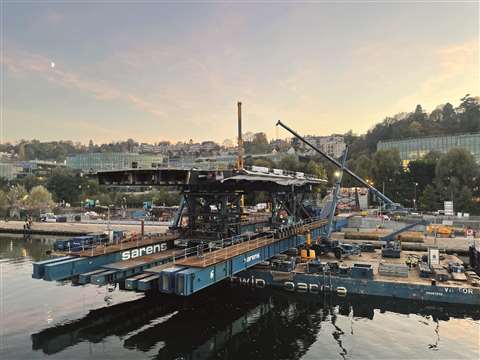 SPMTs allow for safe and quick rigging applications on land and water. Photo: Sarens
SPMTs allow for safe and quick rigging applications on land and water. Photo: Sarens
Safe and fast
It’s been said that in times of crisis, we inevitably rise to achieve some of our greatest successes. An extraordinary example of this was when a hurricane engulfed the Gulf Coast of the U.S. with storm surge. It washed away or displaced a large number of bridge spans over Lake Pontchartrain. Intuitive thinking allowed for a swift response for reconstruction of the 24-mile-long bridge by utilizing SPMTs as the main tool. The SPMT units were used on a barge which allowed for safely lifting each span with the hydraulic compensation stroke and then shifting the displaced sections back into position using the drive function.
This was the safest and fastest means to reconstruct the spans and reopen the bridge for public traffic. The construction team had quickly identified the efficiency to be realized by the SPMT on the barge in comparison to utilizing several barge cranes, tugs and jacking equipment thus setting the stage for a great accomplishment. Ultimately, the SPMT, tug, barge and crew completed between 16 to 19 spans per day, minimizing costs and reducing the construction schedule.
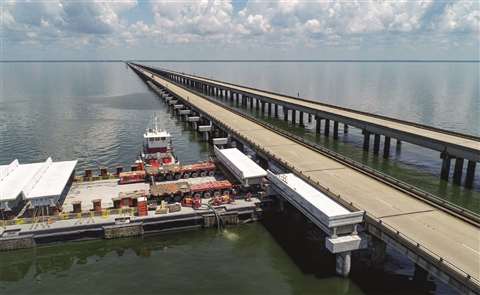 SPMTs can make a job look easy, even though intricate engineering and technical planning was required to successfully complete the rigging application. Photo: Mammoet
SPMTs can make a job look easy, even though intricate engineering and technical planning was required to successfully complete the rigging application. Photo: Mammoet
The in-plant use of SPMTs has evolved with smaller module sizes and various design features that often lend themselves to similar innovative techniques. Congested factories, limited accessways and overhead obstructions have always promoted wheeled dollies, skates, rollers, forklifts or slide systems as the preferred methods to remove and install necessary BOP equipment. The in-plant SPMT can offer enhanced safety with a secured load during movement, lifting and lowering capabilities for setting and removing components, crab steering with cushing, non-marring tires allowing for use in most all facilities and a minimized low height for keeping the center of gravity as low to the floor as possible.
Maneuverability and time are key inside an operational plant and SPMTs offer the versatility of attaching articulating cranes, turntables, load skidding systems, unloading frames, hydraulic lift systems or other up-ending /down-ending fixtures creating a unique rigging or lifting tool. This type of combined rigging use is promising for future applications in specialized production and power facilities as we see the risks of multi-handling components and labor-intense rigging procedures add unnecessary exposure and potential costs to projects.
Versatility plus
The current potential for unique challenges in domestic infrastructure projects and the anticipated expansion in offshore wind development for the U.S. will, undoubtedly, create more diverse project applications for the SPMT. We already see the consistent use of jack-up systems and SPMTs to satisfy Accelerated Bridge Construction (ABC) projects.
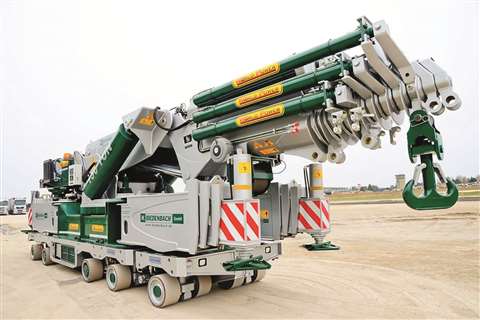 The realm of possibility is huge when combining an SPMT with another lifting tool, including a specialty crane. Photo: Biedenbach
The realm of possibility is huge when combining an SPMT with another lifting tool, including a specialty crane. Photo: Biedenbach
In these applications, the jack-up system used in tandem with the SPMT offers a stable, high-capacity platform and lifting capabilities at significant elevations to safely and quickly remove and replace road/rail bridge spans. This process reduces overall costs, improves project operation efficiency while significantly reducing rail and road traffic delays. The operation becomes even more demanding when you combine these systems on a barge maneuvered in a busy waterway.
I would be remiss to not pay tribute to the hardworking and trained technicians who operate these amazing machines, as well as the clever and creative engineers who push the boundaries of use and expand the “art of possible.” The SPMT is a tool that has limitations that are defined by the expertise and experience of the individuals and companies responsible for their operation.
The manufacturers of the SPMT, while working in conjunction with some of the world’s best contractors, continue to challenge our intellect with their products. I will continue to be astonished by the new ways that colleagues explore rigging uses for the SPMT, and I look forward to learning from and collaborating with these “outside-the-box” thinkers. Without question, the SPMT should be ranked as one of the most useful tools in the history of the heavy lift and transport industry.

A 26-year veteran of the crane and rigging industry, Eddy Kitchen is in his 15th year as owner of Kitchen’ Crane & Equipment and his fifth year as co-owner of Engineered Rigging. His business focus is on all things heavy lifting, transport equipment rental and sales, rigging solutions and engineering services.
STAY CONNECTED


Receive the information you need when you need it through our world-leading magazines, newsletters and daily briefings.



